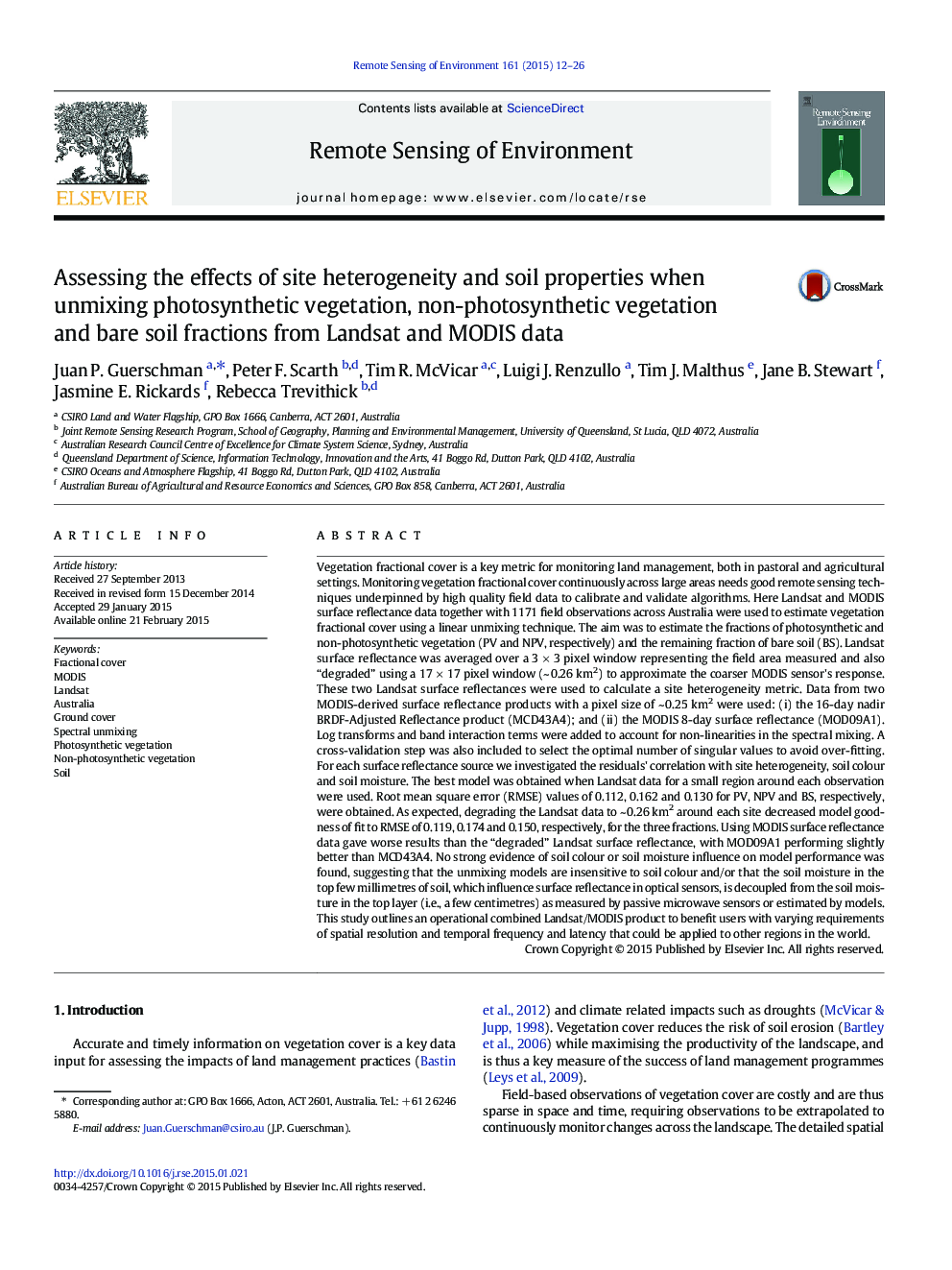| کد مقاله | کد نشریه | سال انتشار | مقاله انگلیسی | نسخه تمام متن |
|---|---|---|---|---|
| 6346149 | 1621239 | 2015 | 15 صفحه PDF | دانلود رایگان |
عنوان انگلیسی مقاله ISI
Assessing the effects of site heterogeneity and soil properties when unmixing photosynthetic vegetation, non-photosynthetic vegetation and bare soil fractions from Landsat and MODIS data
دانلود مقاله + سفارش ترجمه
دانلود مقاله ISI انگلیسی
رایگان برای ایرانیان
کلمات کلیدی
موضوعات مرتبط
مهندسی و علوم پایه
علوم زمین و سیارات
کامپیوتر در علوم زمین
پیش نمایش صفحه اول مقاله

چکیده انگلیسی
Vegetation fractional cover is a key metric for monitoring land management, both in pastoral and agricultural settings. Monitoring vegetation fractional cover continuously across large areas needs good remote sensing techniques underpinned by high quality field data to calibrate and validate algorithms. Here Landsat and MODIS surface reflectance data together with 1171 field observations across Australia were used to estimate vegetation fractional cover using a linear unmixing technique. The aim was to estimate the fractions of photosynthetic and non-photosynthetic vegetation (PV and NPV, respectively) and the remaining fraction of bare soil (BS). Landsat surface reflectance was averaged over a 3Â ÃÂ 3 pixel window representing the field area measured and also “degraded” using a 17Â ÃÂ 17 pixel window (~Â 0.26Â km2) to approximate the coarser MODIS sensor's response. These two Landsat surface reflectances were used to calculate a site heterogeneity metric. Data from two MODIS-derived surface reflectance products with a pixel size of ~Â 0.25Â km2 were used: (i) the 16-day nadir BRDF-Adjusted Reflectance product (MCD43A4); and (ii) the MODIS 8-day surface reflectance (MOD09A1). Log transforms and band interaction terms were added to account for non-linearities in the spectral mixing. A cross-validation step was also included to select the optimal number of singular values to avoid over-fitting. For each surface reflectance source we investigated the residuals' correlation with site heterogeneity, soil colour and soil moisture. The best model was obtained when Landsat data for a small region around each observation were used. Root mean square error (RMSE) values of 0.112, 0.162 and 0.130 for PV, NPV and BS, respectively, were obtained. As expected, degrading the Landsat data to ~Â 0.26Â km2 around each site decreased model goodness of fit to RMSE of 0.119, 0.174 and 0.150, respectively, for the three fractions. Using MODIS surface reflectance data gave worse results than the “degraded” Landsat surface reflectance, with MOD09A1 performing slightly better than MCD43A4. No strong evidence of soil colour or soil moisture influence on model performance was found, suggesting that the unmixing models are insensitive to soil colour and/or that the soil moisture in the top few millimetres of soil, which influence surface reflectance in optical sensors, is decoupled from the soil moisture in the top layer (i.e., a few centimetres) as measured by passive microwave sensors or estimated by models. This study outlines an operational combined Landsat/MODIS product to benefit users with varying requirements of spatial resolution and temporal frequency and latency that could be applied to other regions in the world.
ناشر
Database: Elsevier - ScienceDirect (ساینس دایرکت)
Journal: Remote Sensing of Environment - Volume 161, May 2015, Pages 12-26
Journal: Remote Sensing of Environment - Volume 161, May 2015, Pages 12-26
نویسندگان
Juan P. Guerschman, Peter F. Scarth, Tim R. McVicar, Luigi J. Renzullo, Tim J. Malthus, Jane B. Stewart, Jasmine E. Rickards, Rebecca Trevithick,